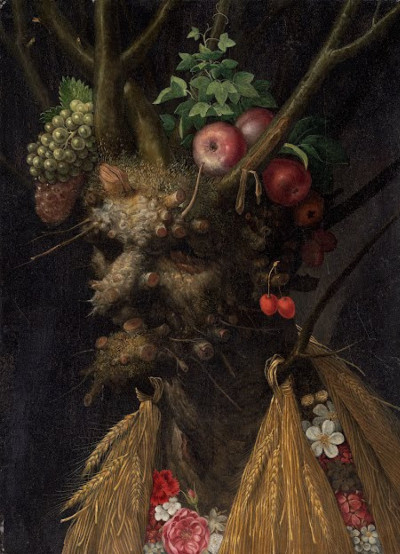The most distinguishing factor of Arcimboldo as a renaissance painter is his paintings of composite heads. He made unique paintings of heads with fruits, plants and other objects, which represented different themes at the moment.
In this particular painting Four Seasons in one Head, also known as Four Elements, he captures them (fire, air, earth and water) perfectly in this portrait. This painting captures all the four seasons that he wished to convey to his audience. Therefore, this article contains important details of the painting; in terms of content and theme. Read on to find out more about it.
Contents of the Painting
The four seasons that the artist illustrates in this painting are summer, winter, autumn and spring. If one is to analyse each season, then they will fully grasp what Arcimboldo intended to convey to his audience. For instance, winter represents coldness and moodiness. From the painting, the fungi that grow on the mouth of the man, to ears and nose that appear twisted, they all represent a sullen appearance. On its first appearance, one notices a tree trunk with plenty of small stumps and is also twisted. The tree trunk represents the Head which signifies the season of winter. On its chest, one notices colourful flowers and wheat that make it look bright. These are excellent characteristics of two seasons; summer and spring. The grapes, ivy and apples that decorate the Head represent the autumn season.
Four Seasons in one Head summarises the artist’s obsession with composite heads. It captures a figure that is in a three quarter view position. The artist intended to show his audience that he is prepared for the afterlife. He had lived his life through all seasons: both in times of plenty and in times of scarcity. The bare trunk and fungi growing on the mouth represent the tough times that he lived through during the renaissance. The juicy grapes, apples and brightly coloured flowers present in spring and summer represent the good life he lived in his life. However, he needed to create a masterpiece that would show the seasons of life, not literary. One can perceive that the artist was somehow ready to leave the face of the earth because three years after he painted his masterpiece, he passed on.
Most artists worldwide associate Arcimboldo’s paintings with the Late Renaissance or mannerism. The artist wanted to show how deep his connection with nature is. Through his paintings, he can communicate serious life situations by simply painting fruits, plants, and other objects using oil on canvas. Lastly, the painting is currently at the National Gallery of Art, Washington DC, in the USA.




